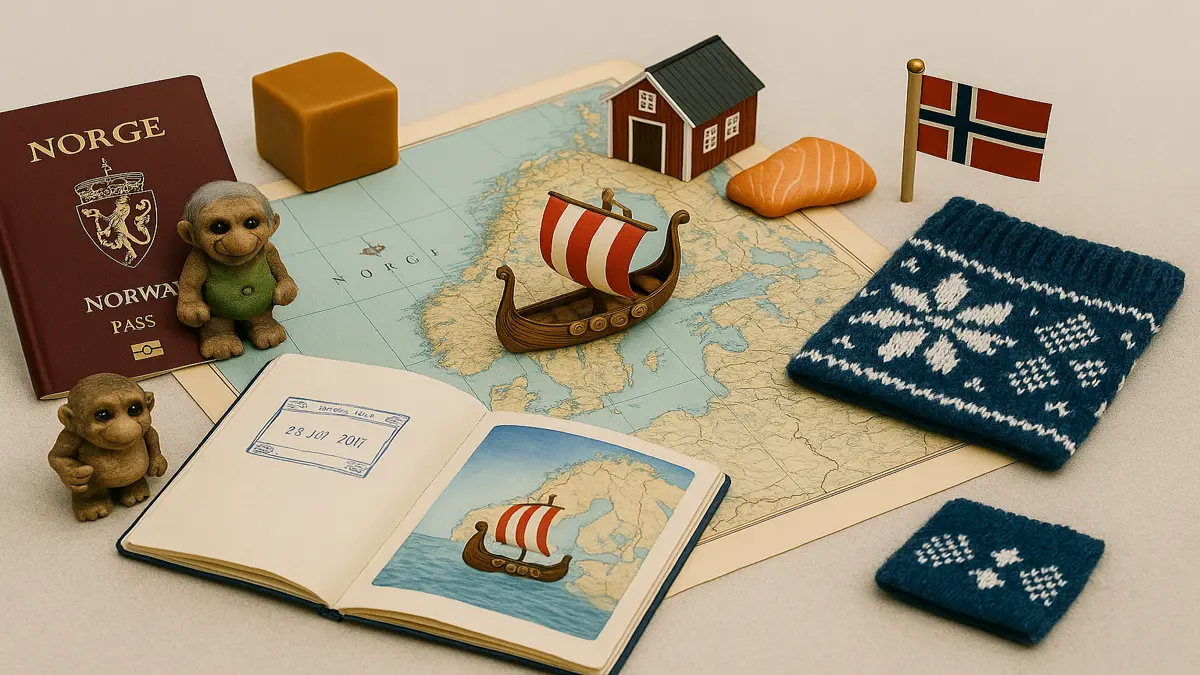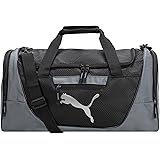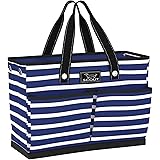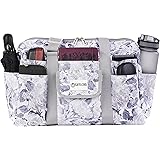Norway Travel Guide 2025: The Ultimate Handbook for First-Time Visitors
Planning your first adventure to Norway in 2025? You’ve chosen a land of breathtaking drama and serene beauty! This ultimate guide is packed with everything you need to know to make your trip unforgettable. From chasing the Northern Lights and cruising through majestic fjords to exploring vibrant cities, we’ve got you covered.
Norway, the legendary land of Vikings and trolls, offers a unique blend of jaw-dropping natural wonders, sleek Scandinavian design, and a deep connection to the outdoors. It’s a country that captivates every traveler, whether you’re hiking to iconic viewpoints or simply enjoying a coffee in a cozy café.
Get ready to discover why Norway is a bucket-list destination for adventurers and nature lovers alike. Let’s dive into the essential tips that will help you plan, budget, and experience the very best of this incredible country.
Table of Contents
- 1. Why Visit Norway in 2025?
- 2. Best Time to Visit Norway
- 3. Top Destinations in Norway for First-Timers
- 4. Planning Your Norway Trip: A Step-by-Step Guide
- 5. Accommodation in Norway: Where to Stay
- 6. Getting Around Norway: Transportation Guide
- 7. How Much Does a Trip to Norway Cost?
- 8. Must-Try Foods and Cultural Delights
- 9. Staying Safe in Norway
- 10. Solo Travel in Norway
- 11. Traveling Norway with Family or as a Senior
- 12. Digital Nomads in Norway
- 13. Essential Packing List in our Norway Travel Guide
- 14. FAQs for First-Timers
- 15. What’s Next? More Guides to Explore
1. Why Visit Norway in 2025?
2025 is a fantastic year for your inaugural Norwegian adventure. The country is at the forefront of sustainable tourism, offering authentic experiences that connect you deeply with its pristine, powerful nature. It’s a destination that perfectly aligns with the growing desire for meaningful, activity-based travel.
The Allure of the Land of Fjords
Imagine cruising silently through majestic fjords, hiking to jaw-dropping viewpoints high above the clouds, or witnessing the ethereal dance of the Northern Lights. Norway offers all this and more. The country boasts a safe and clean environment, a unique “slow travel” vibe, and a culture deeply rooted in nature.
From the modern architecture of Oslo to the dramatic, untamed beauty of the Lofoten Islands, Norway promises a journey filled with awe-inspiring moments. It’s a place where adventure and tranquility coexist in perfect harmony.
ETIAS Update for 2025
Good news for travelers! The European Travel Information and Authorization System (ETIAS) is still not required for U.S. and other visa-exempt travelers visiting the Schengen Area in 2025. Its implementation has been postponed to mid-2026. This means that for your 2025 trip, the current visa-exempt entry rules will remain in effect, simplifying your pre-trip preparations.
Looking for the best hotel or flight deals?
Plan your trip with ease using the Expedia search tool below. From charming boutique hotels to luxury resorts, this widget helps you compare top options in seconds — flights included!
2. Best Time to Visit Norway
Choosing when to visit Norway is crucial, as the country offers two completely different, yet equally magical, experiences depending on the season.
Summer (June to August): Land of the Midnight Sun
- Pros: Longest days (with 24-hour daylight in the north), warmest weather, and all hiking trails and roads are open. It’s the best time for fjord cruises, hiking (Trolltunga, Preikestolen), and road trips.
- Cons: Peak tourist season, meaning higher prices and more crowds at popular spots.
- Best For: Hiking, road trips, fjord exploration, and experiencing the unique phenomenon of the Midnight Sun.
Winter (November to March): The Magical Northern Lights
- Pros: The prime season for seeing the Northern Lights (Aurora Borealis). Snow-covered landscapes create a winter wonderland perfect for dog sledding, skiing, and staying in cozy cabins.
- Cons: Very short daylight hours (or polar night in the far north), cold temperatures, and some roads may be closed.
- Best For: Northern Lights chasing, winter sports, and unique Arctic experiences.
Shoulder Seasons (May & September-October): The Best of Both Worlds
- Pros: Fewer crowds, lower prices, and beautiful scenery. May offers blooming flowers and melting waterfalls, while September boasts stunning autumn colors (“ruska”). The Northern Lights season begins in September.
- Cons: Weather can be unpredictable. Some hiking trails or mountain passes might be closed.
- Best For: A balance of good weather, fewer people, and specific natural beauty like spring blooms or autumn foliage.
Recommendation for First-Timers: For hiking and fjords, choose June-August. For the Northern Lights and a winter wonderland, aim for December-February.
Make Your Travel Moments Go Viral — Instantly
Your next viral Reel and Tiktok is just a Flipstik away. Film hands-free on buses, beaches, or balconies—anywhere your phone can stick.
🎯 Click here and gear up like a creator!3. Top Destinations in Norway for First-Timers
For your first trip, it’s best to focus on a mix of stunning nature and vibrant cities. These destinations provide a perfect introduction to Norway’s diverse appeal.
Bergen: The Gateway to the Fjords
This charming city is surrounded by mountains and fjords. Explore the historic Bryggen wharf (a UNESCO site), ride the Fløibanen funicular for panoramic views, and enjoy the lively fish market.
The Norwegian Fjords (Nærøyfjord & Geirangerfjord)
These UNESCO-listed fjords are the heart of Norway’s natural beauty. Take a fjord cruise from towns like Flåm or Gudvangen to witness towering cliffs, cascading waterfalls, and serene waters.
Oslo: The Modern Capital
A vibrant city with world-class museums (the Munch Museum, the National Museum), innovative architecture (the Opera House), and beautiful parks. It’s a hub of Scandinavian culture and design.
Lofoten Islands: Dramatic Scenery Above the Arctic Circle
A chain of islands known for their dramatic peaks, sheltered bays, and picturesque fishing villages (rorbuer). Perfect for hiking, kayaking, and seeing both the Midnight Sun and Northern Lights.
Tromsø: The Arctic Capital
Located far north, Tromsø is a prime destination for Northern Lights viewing in winter and experiencing the Midnight Sun in summer. It’s a lively city with a stunning Arctic Cathedral and numerous tour operators for husky sledding and whale watching.
Stavanger: Base for Iconic Hikes
The perfect base for tackling two of Norway’s most famous hikes: Preikestolen (Pulpit Rock) and Kjeragbolten. The city itself is charming with its old wooden houses.
4. Planning Your Norway Trip: A Step-by-Step Guide
Planning a trip to a country as vast as Norway requires some organization. Follow these steps for a smooth process.
Setting Your Budget & Travel Style
Before anything else, decide on your budget. Norway is expensive. Be realistic about your budget, as this will influence the length of your trip, your style of accommodation, and the activities you can afford.
Crafting Your Itinerary
Don’t try to see everything. For a 7-10 day trip, focus on one or two regions. A classic first-timer route is Oslo -> Bergen -> Fjords. For a winter trip, you might fly directly to Tromsø or the Lofoten Islands.
Booking Flights & Accommodation
Book international flights 4-6 months in advance. For accommodation, especially in popular places like Lofoten or Flåm, book even earlier (6-12 months), as options are limited and fill up fast.
Understanding Visa & Entry Requirements
For most nationalities (e.g., US, Canadian, Australian, EU citizens), a visa is not required for tourist stays up to 90 days. As mentioned, ETIAS is not required for 2025. Ensure your passport is valid for at least six months beyond your intended departure date.
Securing Travel Insurance
Non-negotiable. Get comprehensive insurance that covers trip cancellations, medical emergencies, and any adventure activities you plan to do. It’s a small investment for peace of mind.
5. Accommodation in Norway: Where to Stay
From cozy cabins to modern hotels, Norway has accommodation for every style, though budget options require careful planning.
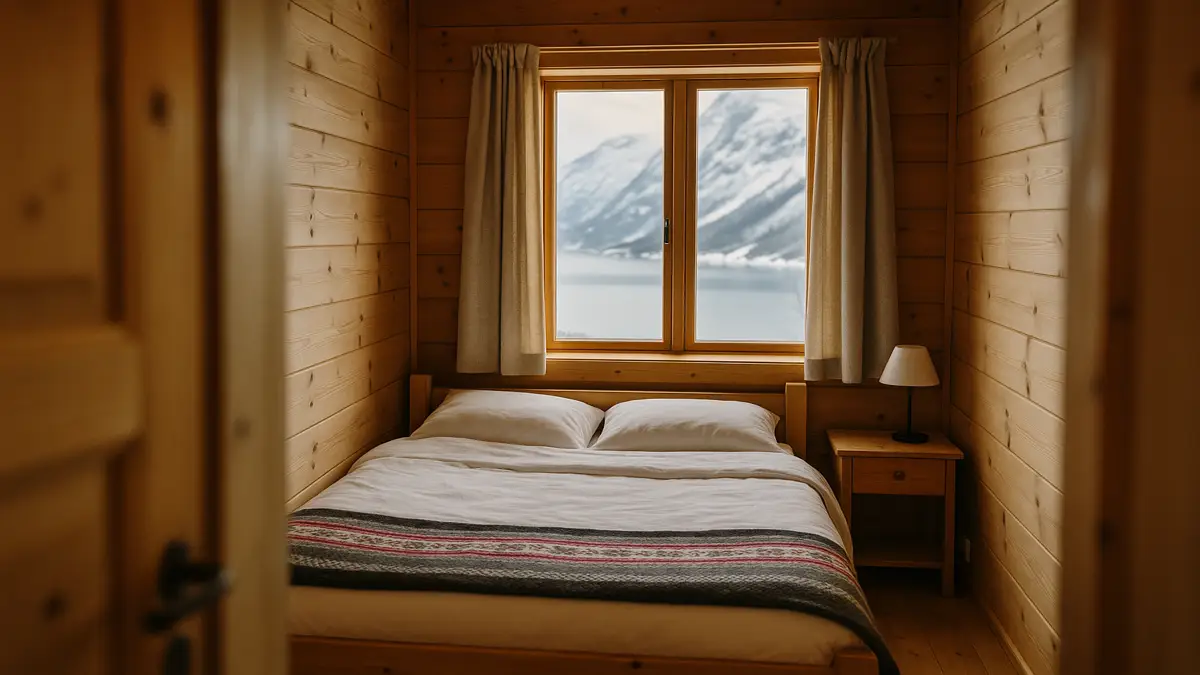
Hotels: Modern Comfort
The most common option in cities and towns. Quality is high, but so are the prices. Chains like Scandic and Thon are reliable mid-range choices.
Cabins (Hytter): The Authentic Choice
A classic Norwegian experience. You can find everything from basic camping cabins to luxurious log cabins with saunas. Fantastic for a self-catering stay surrounded by nature.
Rorbuer (Fishermen’s Cabins): Coastal Charm
Found in the Lofoten Islands and other coastal areas, these are traditional cabins, often built on stilts over the water. Many have been beautifully modernized for a unique stay.
Hostels & Guesthouses: Budget-Friendly
The best option for budget travelers. They are clean and safe but can be less common outside of major cities. Book well in advance.
Self-Catering & Vacation Rentals
Platforms like Airbnb are a great option for finding apartments in cities or unique stays in rural areas, often providing better value than hotels for families or groups.
6. Getting Around Norway: Transportation Guide
Navigating Norway’s challenging geography is an adventure in itself. The transport system is modern and efficient, designed to handle the terrain.
Driving (Car Rental): Ultimate Freedom
- Pros: The ultimate freedom and flexibility. A car is almost essential for exploring regions like the Lofoten Islands or the scenic tourist routes at your own pace.
- Cons: Expensive (rental, fuel, tolls, ferries). Roads can be narrow and winding. Winter driving requires experience. Driving is on the right side.
- Tips: Book an automatic if you’re not used to a manual. Be prepared for numerous ferries and tunnels, which often have separate tolls.
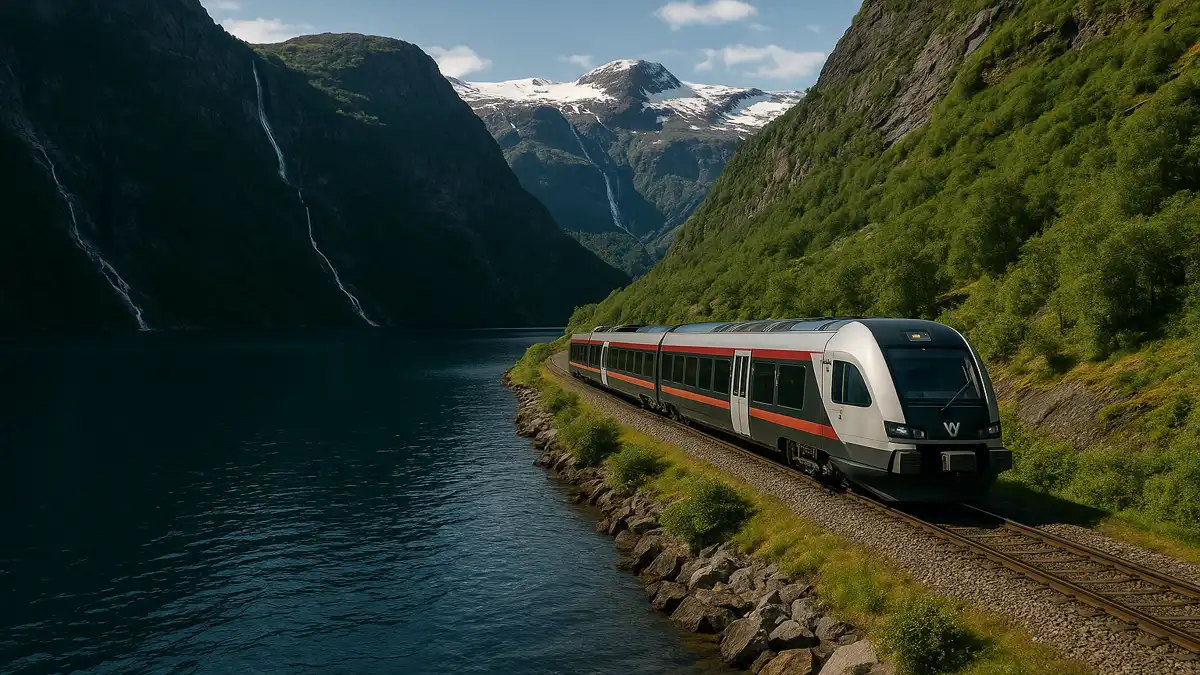
Trains: Scenic & Comfortable
- Pros: Comfortable and incredibly scenic. The journey from Oslo to Bergen is considered one of the world’s most beautiful train rides. The Flåm Railway is another iconic journey.
- Cons: The network is limited, mainly connecting the southern cities. It doesn’t extend far into the fjordlands or the north.
- Booking: Book in advance on the official “Vy” railway website for cheaper “Minipris” tickets.
Ready to book your train tickets hassle-free?
Search routes and compare prices on Trainline – your one-stop platform for rail travel across Europe.
Flights: For Vast Distances
- Pros: The most practical way to cover the vast distance from southern Norway (Oslo) to the north (Tromsø, Lofoten, etc.).
- Cons: You miss the scenery. Book well in advance for reasonable prices.
- Airlines: SAS, Norwegian, and Widerøe are the main domestic carriers.
Ferries & Fjord Cruises: Essential for the West
- Pros: An integral part of travel in Western Norway. Car ferries are like floating bridges, and passenger cruises are the best way to experience the fjords. The Hurtigruten coastal ferry is a famous multi-day journey along the coast.
Ready to book your train tickets hassle-free?
Search routes and compare prices on Trainline – your one-stop platform for rail travel across Europe.
7. How Much Does a Trip to Norway Cost?
There’s no sugarcoating it: Norway is one of the most expensive countries in the world. However, with smart planning, you can manage your costs. Activities, food, and alcohol are the biggest budget items.
Daily Cost Estimates (Per Person)
- Budget Traveler: €80-130 / $90-145 USD per day
- Accommodation: Hostels, basic cabins, camping.
- Food: Cooking all your own meals from supermarkets (REMA 1000, Kiwi).
- Transport: Public transport, lots of hiking.
- Activities: Mostly free activities like hiking.
- Mid-Range Traveler: €200-350 / $220-385 USD per day
- Accommodation: Mid-range hotels, Airbnb, nicer cabins.
- Food: Mix of self-catering and casual restaurant meals.
- Transport: Car rental (split between travelers) or public transport.
- Activities: One paid activity per day (e.g., fjord cruise, museum).
- Luxury Traveler: €400+ / $440+ USD per day
- Accommodation: High-end hotels, boutique lodges.
- Food: Fine dining, frequent restaurant meals.
- Transport: Flights, private transfers, premium car rental.
- Activities: Private tours, multiple guided activities.
Money-Saving Tips:
- Cook Your Own Food: Eating out is incredibly expensive. Prioritize accommodation with a kitchen. Supermarkets are your best friend.
- Drink Tap Water: Norwegian tap water is pure, delicious, and free.
- Limit Alcohol: Alcohol is heavily taxed and very expensive. Buy at the airport duty-free if you plan to drink.
- Focus on Hiking: Norway’s greatest attraction—its nature—is free.
- Book Everything in Advance: This is the single best way to save on transport and accommodation.
- Travel in a Group: Sharing the cost of a rental car and self-catering accommodation makes a huge difference.
8. Must-Try Foods and Cultural Delights
Norwegian cuisine is shaped by its long coastline and harsh winters, focusing on preserved foods and high-quality fresh ingredients.
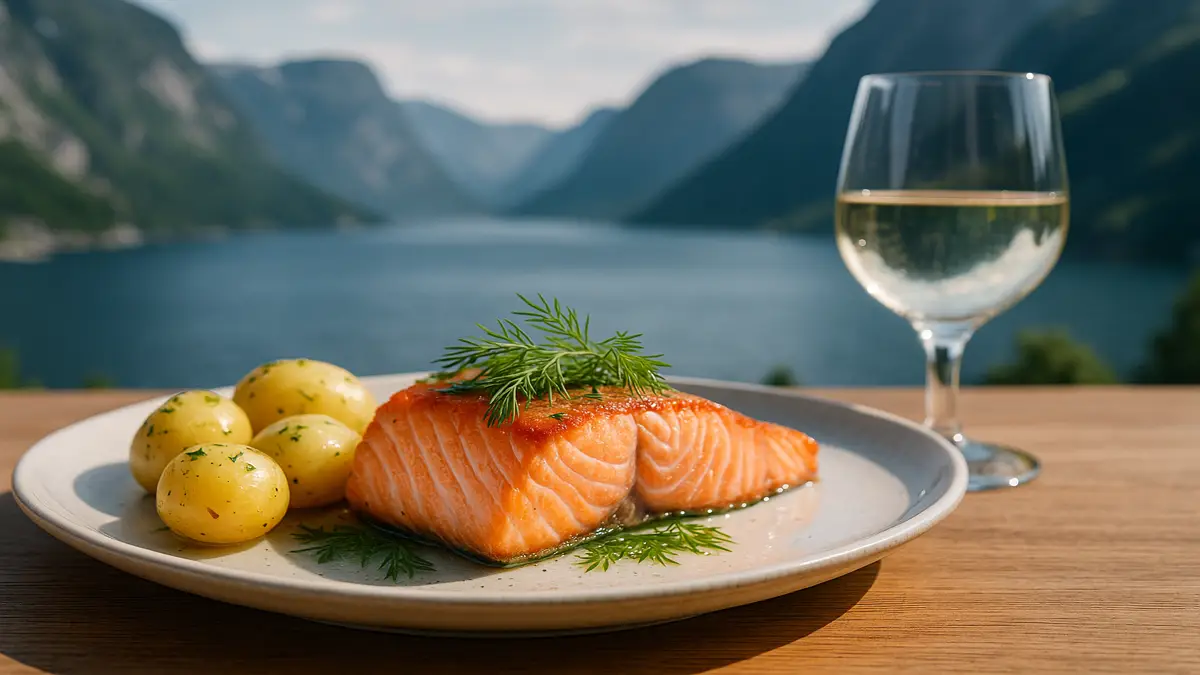
Iconic Norwegian Dishes
- Fårikål: Norway’s national dish, a simple but hearty stew of mutton, cabbage, and black peppercorns.
- Salmon (Laks): Enjoy it smoked, cured (gravlaks), or freshly grilled. The quality is exceptional.
- Brown Cheese (Brunost): A sweet, caramel-like cheese that is uniquely Norwegian. Often eaten on bread or waffles.
- Waffles (Vafler): Thinner and softer than Belgian waffles, typically served with sour cream and jam or brown cheese.
- Pølse i Lompe: A hot dog served in a thin potato flatbread instead of a bun. A classic street food.
- Cinnamon Buns (Kanelboller/Skillingsboller): A beloved Norwegian pastry, perfect for a coffee break.
The “Kos” Culture: More Than Just Coziness
Similar to Danish “hygge,” “kos” (or “koselig”) is the Norwegian feeling of coziness, warmth, and contentment. It can be found in a candlelit cabin, a shared coffee with a friend, or a warm wool sweater.
Cultural Etiquette & Local Customs
- Friluftsliv: The “open-air life” philosophy is central to Norwegian culture. It’s the love of being outdoors, whatever the weather.
- Personal Space: Norwegians are generally reserved and value their personal space. Small talk with strangers is not as common as in other cultures.
- Punctuality: Being on time is very important.
- Modesty: Humility is a virtue. Bragging or being loud is generally frowned upon.
9. Staying Safe in Norway
Norway is one of the safest countries in the world, with extremely low crime rates. The biggest safety concerns are related to nature and weather, not people.
General Safety Tips
- Be Aware of Your Surroundings: While very safe, take normal precautions against petty theft in busy areas of Oslo or Bergen.
- Protect Your Valuables: Don’t leave valuables unattended, especially in cars at trailheads.
- Trust Your Gut: If a situation feels off, it probably is.
Mountain & Weather Safety
This is the most important consideration. Weather can change in an instant. Here’s how to stay safe:
- Check the Forecast: Use apps like Yr.no.
- Dress in Layers: Wear appropriate layered clothing (wool/synthetics) and sturdy, waterproof hiking boots.
- Pack Accordingly: Bring extra food, water, a map, and a fully charged phone.
- Respect Nature: Stay on marked trails and do not attempt famous hikes like Trolltunga in bad weather or without being physically prepared.
Emergency Numbers
- The universal emergency number is 112 for police, ambulance, and fire.
10. Solo Travel in Norway
Norway is a fantastic and very safe destination for solo travelers. The respect for personal space and the quiet, contemplative nature of the landscape make it ideal for those seeking solitude and adventure.
Public transport is efficient and easy to navigate alone. Joining group tours for activities like hiking, kayaking, or Northern Lights chasing is a great way to meet people. The biggest challenge for solo travelers is the cost, as you can’t split expenses for car rentals or cabins.
11. Traveling Norway with Family or as a Senior
Norway’s focus on the outdoors and safety makes it a great destination for all ages, with some planning.
Traveling with Family
- Outdoor Focus: Norway is a giant playground for active families. Focus on activities like easy hikes, fishing, and exploring nature. Many trails are family-friendly.
- Accommodation: Renting a “hytte” (cabin) is a great option, providing space and kitchen facilities to save on food costs.
- Pacing: Don’t underestimate travel times. Distances are vast, and roads are slow. Plan for a more relaxed pace with plenty of stops.
Traveling as a Senior
- Accessibility: Cities are generally accessible, but the main attractions are natural and can involve uneven terrain.
- Cruises: Fjord cruises and the Hurtigruten coastal ferry are excellent, comfortable ways to see the stunning coastline without strenuous activity.
- Comfort: Prioritize comfortable, waterproof footwear and layered clothing. The weather can be challenging at any age.
- Public Transport: The train and bus systems are comfortable and reliable, making them a great alternative to driving.
13. Essential Packing List in our Norway Travel Guide
Packing correctly for Norway is essential for your comfort and safety. The key is layers, layers, layers!
Clothing
- Waterproof and Windproof Outer Layer: A high-quality jacket and pants are non-negotiable for any season.
- Mid-Layers: Fleece jackets or wool sweaters.
- Base Layers: Thermal underwear (wool or synthetic) is essential for winter and highly recommended for hiking in other seasons.
- Sturdy, Waterproof Hiking Boots: The single most important item you will pack.
- Warm Socks: Wool socks are best. Bring plenty.
- Hat, Gloves, and Scarf: Essential for winter, and useful even in summer at high altitudes.
Essentials & Accessories
- Universal Travel Adapter: Norway uses Type F plugs (two round pins).
- Portable Power Bank: Cold weather can drain phone batteries quickly.
- Reusable Water Bottle: To fill up with delicious tap water.
- Daypack: For daily excursions, carrying water, snacks, and extra layers.
- Sunscreen and Sunglasses: The sun can be strong, especially when reflected off snow or water.
- Sleep Mask: A must-have for sleeping during the Midnight Sun in summer.
As an Amazon Associate, we earn from qualifying purchases.
14. FAQs for First-Timers
Here are some frequently asked questions to help ease any remaining concerns about your first trip to Norway.
Is Norway expensive to visit?
Yes. It is consistently ranked as one of the most expensive countries in the world. Budget carefully, especially for food and activities. Cooking your own meals is the best way to save money.
Do I need a visa for Norway in 2025?
For most nationalities (e.g., US, Canadian, Australian, EU citizens), a visa is not required for tourist stays up to 90 days. The ETIAS system is not expected to be in effect for 2025.
What’s the best way to get around Norway?
For flexibility, renting a car is best, especially for the fjords and Lofoten. For city-to-city travel, trains are scenic and comfortable. For long distances to the north, flying is most practical.
What should I pack for Norway?
Layers are essential. A waterproof jacket and pants, waterproof hiking boots, fleece/wool sweaters, and thermal base layers are key for any season.
Is it safe to travel solo in Norway?
Yes, Norway is extremely safe for solo travelers. The main safety concerns are related to weather and mountain hiking, not crime.
Can I use my credit card everywhere?
Credit and debit cards are widely accepted everywhere. It’s possible to travel almost cashless. However, it’s wise to have a small amount of cash for emergencies.
What’s the currency in Norway?
Norway uses the Norwegian Krone (NOK), not the Euro.
What are my chances of seeing the Northern Lights?
In Northern Norway (Tromsø, Lofoten) from late September to late March, your chances are very high on clear nights. However, it is a natural phenomenon and never guaranteed.
15. What’s Next? More Guides to Explore
Your Norwegian adventure awaits! We hope this comprehensive guide has equipped you with all the essential information to plan an unforgettable trip to the land of fjords and legends. From the vibrant streets of Oslo to the epic landscapes of the Arctic, Norway promises a journey that will stay with you forever.
Happy travels, and enjoy your epic journey through Norway!
Related Articles to Inspire Your Next Adventure:
🇪🇺 Western Europe
🇪🇺 Southern Europe
🇪🇺 Northern Europe
🇪🇺 Central Europe
🇪🇺 Eastern Europe & Baltics
🌍 Continental Overview
References:
European Union. (2025, April 14). Revised timeline for the EES and ETIAS. Retrieved from Official EU Site
